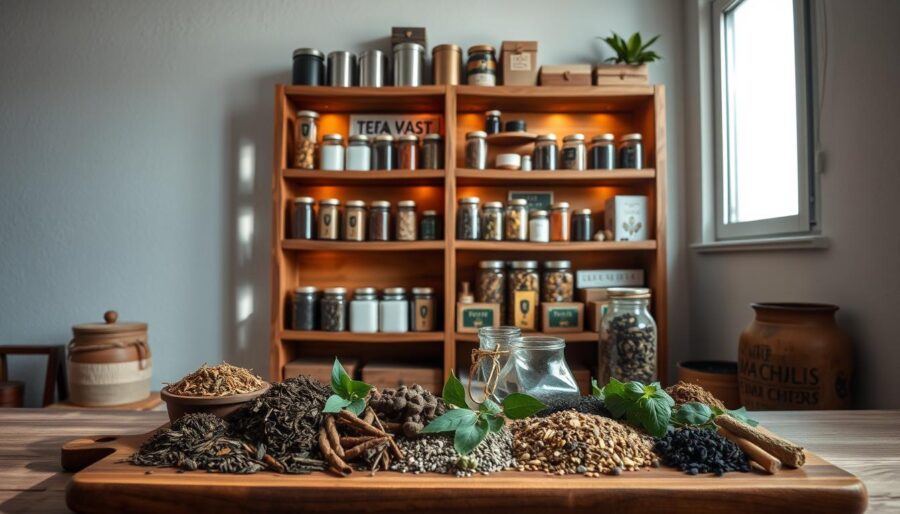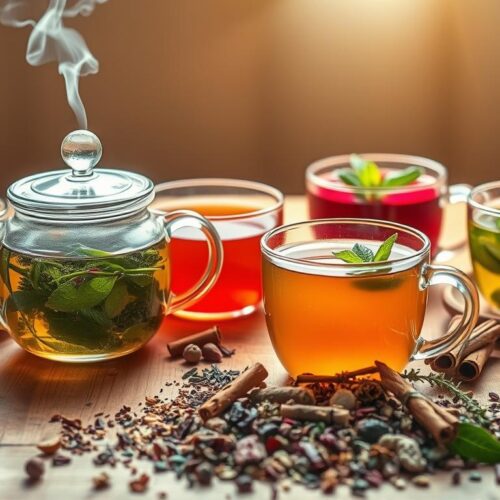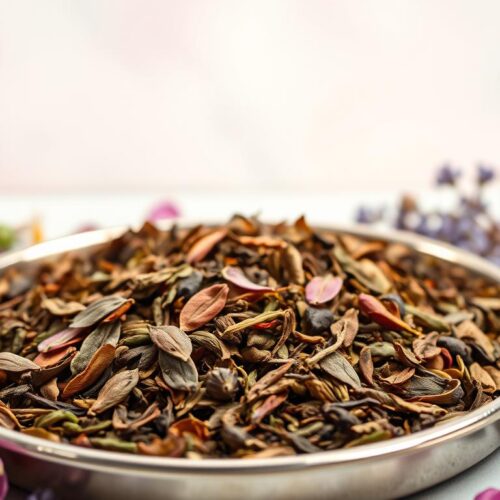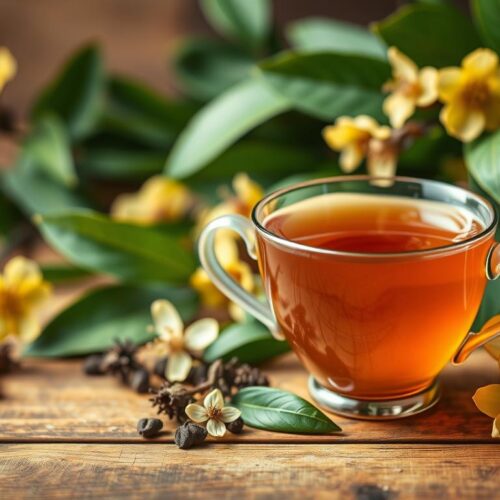Everyone loves a cup of tea with a bright aroma and clean taste. This guide shows you how to protect your tea from light, air, moisture, odors, and heat. By following these tips in the United States, you can keep your tea fresh longer.
In the past, people kept tea fresh using Chinese porcelain canisters, lacquered wood boxes, and sealed clay or metal containers. These methods help block light and reduce oxygen. Now, you can use airtight, opaque tins or jars for the same effect. Just store them in a cool, dark, dry place, like a cabinet or pantry, away from appliances and windows.
Teas don’t really “expire” like milk does; they just lose their freshness. With the right storage, green and white teas can last 6–12 months after opening. Black teas and dark oolongs can last 12–18 months. Herbal teas are usually good for 6–12 months. Some pu-erh and aged white teas even get better with time.
It’s best not to store opened tea in the fridge or freezer. This can make the tea lose its flavor. However, freezing can work for unopened, vacuum-sealed premium teas like Gyokuro or matcha. Just be sure to thaw them carefully. Following these tea storage tips can help you reduce waste and keep your tea tasting great.
Why Proper Tea Storage Matters
Tea is delicate. Flavor can quickly fade when exposed to light, air, heat, and smells. Knowing how to store your tea is key. It helps keep its aroma and color from fading. By slowing the decline of essential oils, your tea remains vibrant and full of flavor.
UV light harms chlorophyll and volatile compounds, especially in green and lightly oxidized teas. Oxygen triggers unwanted oxidation, dulling diverse flavors from jasmine to malt. Heat accelerates this process, shortening tea’s shelf life often sooner than you realize.
Tea absorbs moisture, so controlling tea’s moisture is crucial. Even a little dampness can make your tea stale or moldy. Strong smells from things like coffee or spices can seep into your tea. This leaves flavors that you can’t get rid of, no matter how much you brew.
For hundreds of years, traders have used airtight, opaque tins to keep tea fresh. This method is still effective today. A good tea storage guide ensures your tea’s structure and delicate aromas are protected. That means green teas can stay fresh for months, and black teas maintain their richness and aroma for longer.
Some teas, like Pu-erh and certain aged white teas, need special care. They’re stored under specific conditions, not just anywhere in your kitchen. Understanding how to balance protection and aging is important. It helps make sure your tea keeps its best quality without getting too moist or picking up weird flavors.
Ideal Tea Storage Containers
Choose airtight containers with snug lids to keep out air and moisture. Opaque walls protect the aroma and color from light. For daily storage, remember: airtight and opaque is best.
Tin and stainless steel canisters are top choices. They’re inert, long-lasting, and easy to clean. Use glazed ceramic with silicone or cork seals. Avoid unglazed ceramic, as it might let scents escape.
Dark or UV-protective glass is good, but only in a dark cabinet. Stay away from clear glass to prevent flavor loss. Each tea type should have its own caddy to avoid mixing odors.
Be careful with plastics, as they can taint your tea’s flavor. Paper bags aren’t great for long-term storage. Yet, foil-lined, resealable opaque pouches work well for short periods. Just squeeze out extra air.
Divide big purchases into smaller containers to reduce empty space. This advice follows traditional practices, from China’s porcelain canisters to airtight metal pots. Stick with inert metals and glazed ceramics for daily use.
Store strong-smelling spices like cloves or ginger in airtight glass jars. Then, keep your teas in separate, odor-free tins. By doing this, your tea will maintain its best quality.
Best Practices for Storing Different Types of Tea
To keep tea fresh, follow a storage guide. Each tea type needs a specific method. Store them in airtight, opaque containers in a cool, dark place. Keep air, light, heat, and moisture away to protect the loose leaf tea.
Green tea and light oolong are sensitive. They should be in tight, lightproof containers. Enjoy them within 6–12 months after opening. High-grade teas like Japanese Sencha, Gyokuro, and matcha can be frozen if unopened. Thaw them before use to prevent condensation and flavor loss.
Darker oolongs, like Phoenix Dancong and Wuyi Rock tea, are sturdier. Store them at room temperature in sealed, opaque containers. Keep Phoenix Dancong away from strong smells, as its scent is easily lost.
Black tea is strong but can lose its freshness. Keep it in an airtight, dark place and use it within 12–18 months. White tea is similar to green tea and should be used within 6–12 months, unless specially aged.
Herbal blends need careful handling to maintain their scent. Store them like green and white teas: airtight and away from light. They usually last 6–12 months, but some can stay fresh for up to 3 years if stored well.
Pu-erh tea requires special attention. For aging sheng or shou, use breathable wrappers and keep them in a stable environment. If not aging, store pu-erh like black tea. This helps maintain its freshness.
| Tea Type | Primary Goal | Container & Light | Temperature & Humidity | Use-By After Opening | Notes on How to Store Tea |
|---|---|---|---|---|---|
| Green (Sencha, Gyokuro, matcha) | Preserve freshness | Airtight, opaque | Cool, dark, low humidity | 6–12 months | Unopened, vacuum-sealed packs may be frozen; fully warm before opening to keep tea fresh. |
| Light Oolong | Protect aromatics | Airtight, opaque | Cool, dark, stable | 6–12 months | Treat like green tea in your tea storage guide; limit air exposure for loose leaf tea storage. |
| Dark/Roasted Oolong (Phoenix Dancong, Wuyi, roasted Tieguanyin) | Maintain roast and body | Airtight, opaque | Room temp, odor-free | 12–18 months | Shield Phoenix Dancong from odors; how to store tea here focuses on clean, dry spaces. |
| Black Tea | Prevent staling | Airtight, opaque | Cool, dark, dry | 12–18 months | Rotate stock; keep tea fresh by sealing after every scoop. |
| White Tea | Retain delicate notes | Airtight, opaque | Cool, dark, low humidity | 6–12 months | Age only with controlled conditions; otherwise use soon for best loose leaf tea storage results. |
| Herbal Tisanes | Lock in aroma | Airtight, opaque | Cool pantry, dry | 6–12 months (up to 2–3 years if ideal) | Keep away from heat and sun; follow a tea storage guide to minimize aroma loss. |
| Pu-erh (Sheng & Shou) | Steady maturation | Breathable wrap (paper, bamboo) | Stable temp, controlled humidity | Varies with aging goals | For casual storage, treat like black tea; avoid odors and moisture to keep tea fresh. |
The Importance of Temperature Control
Temperature changes can reduce the life of your tea. Keep it between 50°F and 68°F (10°C to 20°C) to prevent quick oxidation and moisture build-up. Use a cool, dark spot away from appliances and windows for storage.
Light and heat increase the risk of tea getting moist. Stay away from places where kitchen smells and dust gather. For small spaces, storing tea in an always cool pantry is a good idea.
Refrigerators can cause your tea to pick up smells and become too moist. Because tea leaves absorb like sponges, cold air can wreck their scent. Freezing can be an option for special green teas that are vacuum-sealed, but they should be warmed to room temp before use.
How you store tea affects it too. Roasted oolongs prefer room temp if they’re sealed well. For lightly roasted ones, cool places are better, provided the pack is unopened and sealed. Proper temperature management preserves the oils that make tea fragrant and extends its life.
| Storage Option | Temp Range | Pros | Cons | Best Use |
|---|---|---|---|---|
| Cool, dark pantry | 50°F–68°F | Stable, low light, easy access | May vary with seasons | Daily tea storage for black, oolong, puer, most greens |
| Kitchen cabinet away from heat | 55°F–70°F | Convenient and protected | Risk of nearby oven or dishwasher warmth | General use when you watch temperature swings |
| Refrigerator | 35°F–40°F | Cool environment | High humidity, odor transfer, tea moisture issues | Avoid for most teas; not advised for opened packs |
| Freezer (only vacuum-sealed) | 0°F | Slows staling for sealed delicate greens | Condensation when warming; strict handling required | Unopened, truly vacuum-sealed sencha or gyokuro |
| Countertop near window | Variable | None | Heat, light, odors, rapid oxidation | Avoid entirely for any tea storage |
How to Organize Your Tea Collection
Start by sorting your tea shelves by how delicate they are. Put greens, light oolongs, and whites in a cool, dark spot. This keeps them fresh. Have your strong black teas and roasted oolongs in reach. Store pu-erh and teas for aging separately, away from light and smells. This method is like the old tea chests in London and Hong Kong. It’s great for any modern tea storage.
Pick uniform, airtight, and opaque tins or ceramic caddies for neat storage. Don’t mix different teas in one container; their smells will blend. Keep teas away from coffee, spices, candles, and cleaners. Remember, the best way to store tea is in a cool, dark, dry, and smell-free place.
Label each tin with the tea’s name, where you bought it, and when. Use the FIFO method, so you use older tea first. When buying a lot, divide it into smaller portions to keep it fresh. These tips from the United States will help keep your tea’s flavor strong and fresh.
| Category | Ideal Spot | Best Container | Labeling Must-Haves | Rotation Tip | Odor Precautions |
|---|---|---|---|---|---|
| Green, Light Oolong, White | Coolest, darkest cabinet | Opaque airtight tin or ceramic caddy | Tea name, vendor, harvest date, open date | Use within months; check weekly | Keep far from spices and coffee |
| Black, Roasted Oolong | Nearby shelf with stable temps | Sealed tin with tight lid | Tea name, purchase date, open date | FIFO for daily drinkers | Avoid candles and cleaners |
| Pu-erh, Teas for Aging | Dedicated, odor-free zone | Breathable paper wrap inside protective box | Tea name, factory/region, batch, start date | Rotate cakes; track every 3–6 months | Absolute separation from aromas |
| Bulk Purchases | Main cabinet, back row | Several small, filled tins | Lot number, split date | Open one tin at a time | Seal backups in odor-safe bin |
For day-to-day ease, keep a “use now” tin up front and extra ones behind. This setup matches any tea guide. It makes staying fresh easy. With good habits and clear labels, you’ll always know how to keep your tea tasting great. Follow these U.S. storage tips.
Avoiding Common Tea Storage Mistakes
Want your tea to stay fresh? Think of light, air, heat, and moisture as enemies. Although clear glass jars may look appealing, they’re not wise choices for keeping tea. This is because light harms the essential oils in tea. Even minor light impact on your shelf can cause tea leaves to lose their flavor fast. It’s best to use opaque containers and store them in a dark place.
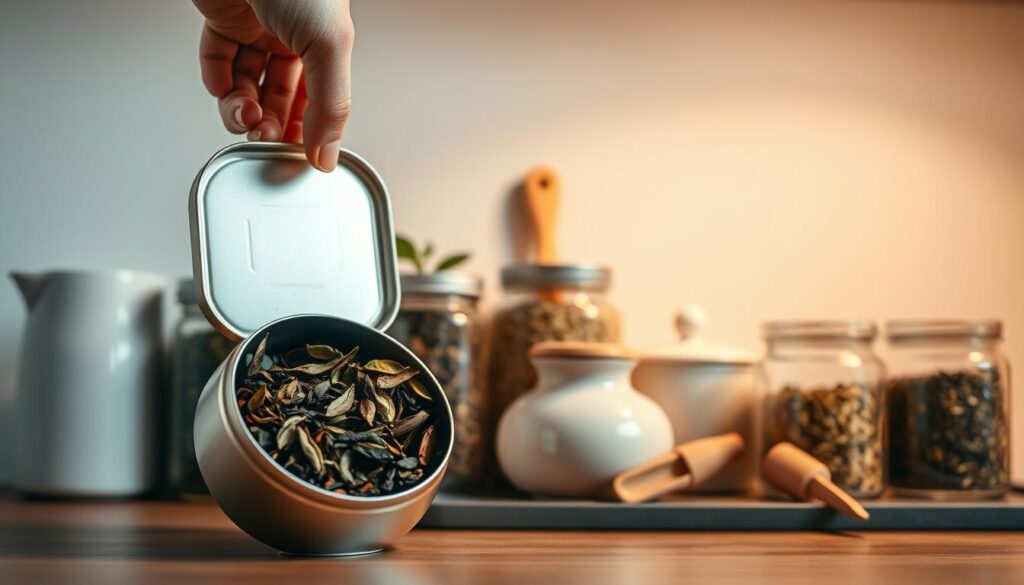
Always seal your tea containers tightly after using them. Loose lids can let in oxygen and moisture. Both can make the tea taste bland and even cause mold. For daily tea storage, opt for containers that are airtight and not see-through. You can use ones made of stainless steel or glazed ceramic, or choose containers that block out harmful UV light. Keep them far from any windows.
It’s important to keep your tea away from heat. You should avoid placing tea near stoves, ovens, or the steamy air from dishwashers. Do not put tea containers over hot kettles or close to sinks where warm steam can reach them. A cool, shady cabinet is the ideal spot for storing tea right.
Never put opened tea in the fridge or freezer. These appliances add unwanted moisture and smells to your tea. However, if your tea is in an unopened, vacuum-sealed package, freezing might be okay for some delicate green teas. Just be sure to let the package warm up before opening it.
Long-term storage in thin paper bags is a bad idea. They allow too much air and light to reach the tea. Also, keep your tea away from strong-smelling items like spices, coffee, or household cleaners. Tea can easily absorb these overpowering smells.
Remember, not all teas stay fresh for the same amount of time. Greens and whites tend to lose their flavor quicker than black and roasted oolong teas. Mark the date on your containers, rotate your stock, and use up the more sensitive teas first. Always close containers tightly to keep out air and maintain the tea’s quality.
- Use airtight, opaque containers; avoid clear glass.
- Store in a cool, dark cabinet to reduce tea light exposure.
- Keep away from heat, humidity, and strong odors.
- No fridge or freezer for opened tea; follow the tea storage guide for sealed packs only.
- Label dates and consume delicate teas sooner.
The Role of Humidity in Tea Storage
Tea loves to soak up moisture from the air. This makes its aroma and texture go stale quickly. To keep your tea fresh, use this guide. It has simple steps to block out dampness.
Pick containers that are airtight. Make sure they close tightly after each use. Keep them far from any place wet, like kettles or sinks. And if you buy a lot of tea, divide it into smaller containers. This minimizes how much air touches the tea each time you use it.
Don’t store your tea in the fridge or freezer. They’re both too humid and can make your tea smell like food. If tea gets cold, then hits warm air, it gets wet. That’s bad for the tea. If you really need to cool your tea, keep it sealed tightly. And wait until it’s room temperature to open it.
Pu-erh tea is different, though. A bit of humidity can help it age, as long as there’s also air moving around it. But, it should still be kept away from strong odors and direct wetness. Otherwise, it won’t age right. For other teas, just remember: keep them dry and sealed.
In homes across the U.S., the weather can change a lot. So, find a spot inside that stays calm and doesn’t get too crazy with temperature. Use these tips to think about the best way to store your tea. This way, you’ll keep it tasting great with little trouble.
- Seal after each use to reduce tea moisture uptake.
- Place containers in a cool, dry, odor-free space.
- Portion bulk buys into smaller jars to limit air exchange.
- Skip refrigerators and freezers unless packaging is unopened and allowed to warm before opening.
- For pu-erh, aim for controlled humidity with clean airflow.
Both history and science agree: keeping moisture away keeps the tea’s flavor and form intact. Follow this guide every day. Then, you’ll always know the best way to keep your tea fresh and flavorful.
Innovative Storage Solutions
Take your tea storage beyond basic tips with smart tools. These tools keep out air, light, heat, and moisture. For special green teas, vacuum-seal unopened packets to reduce oxidation. If freezing sealed Gyokuro or matcha, let it warm to room temperature before opening. This avoids condensation that can reduce tea shelf life.
Choose nitrogen-flushed, foil-lined, resealable pouches from respected sellers like Ippodo, Harney & Sons, or The Tea Spot for everyday use. Then, transfer them to airtight, opaque tins at home to keep the flavor intact. Dark, UV-protective glass jars are good too but only work inside a closed cabinet.
Pick container sizes based on your tea consumption rate. Smaller headspace means less oxygen and extends shelf life. Inspired by Chinese art, choose glazed ceramic with gasketed lids for airtight storage and pure flavor.
Use a separate tin for each type of tea to keep its unique smell. This is especially important for distinct oolongs like Phoenix Dancong, as mixing scents can blur unique tastes. Ensure every tea has its own container and scoop to simplify storage.
Keep your teas easy to reach without exposing them all. Opt for stackable tins and labeled lids, and use a FIFO system to use older tea first. This method keeps your tea collection tidy and fresh.
Consider using small tins for weekly use and keeping extra stock sealed. This method means daily use containers are opened less, reducing air exposure. This simple split paves the way for better storage with minimal effort, safeguarding tea aroma and quality.
- Vacuum-seal strategy: Best for unopened, premium teas. Always thaw before using.
- Pouch-to-tin workflow: Start with nitrogen-flushed pouches, then transfer to opaque tins.
- Right-size containers: Choose the volume according to your tea drinking pace to minimize air exposure.
- Material choice: Choose glazed ceramic with gasket lids for airtight, flavor-preserving storage.
- Aroma control: Dedicate one container per tea type to prevent smells from mixing.
- Inventory flow: Use labeling, stacking, and FIFO method to ensure freshness and longevity.
These innovative tips blend tradition with precision. They convert your tea storage into daily habits that maintain vibrant and consistent flavors throughout the year.
Signs That Your Tea Has Gone Bad
You can find out if your tea’s gone bad before making it. A good guide on storing tea starts with checking the dry leaf. If the leaves look lively and full of color, they’re good. But if they appear dull, dusty, faded, or very brittle, they’re stale. To keep your tea fresh, always compare its color and texture with a new batch.
The smell of the leaves is your next clue. Before you even add water, give them a sniff. Green teas should smell fresh and like vegetables, black teas should have a malty or fruity scent, and oolongs should be floral or toasty. But if the tea smells like paper or hay, it’s probably too old. And if you get a whiff of garlic, spices, or perfume, it means the leaves picked up scents from nearby items because they weren’t stored properly.
Then, pay attention to the brewing process. A weak or strange smell while steeping can indicate the loss of essential oils from the tea. The flavor will confirm your suspicions. Stale tea might taste flat, weak, or dull. It could even taste harsh, surprisingly bitter, or astringent compared to earlier brews. If the tea doesn’t taste right anymore, get a new batch and check your tea storing habits.
Mold, a musty smell, or tea leaves sticking together shows moisture got in. You should throw it out. Remember, some teas like pu-erh and aged white teas can get better under the right conditions. But random stale tastes from heat, light, air, or smells mean something went wrong. Keep your tea fresh and make it last longer by storing it smarter.
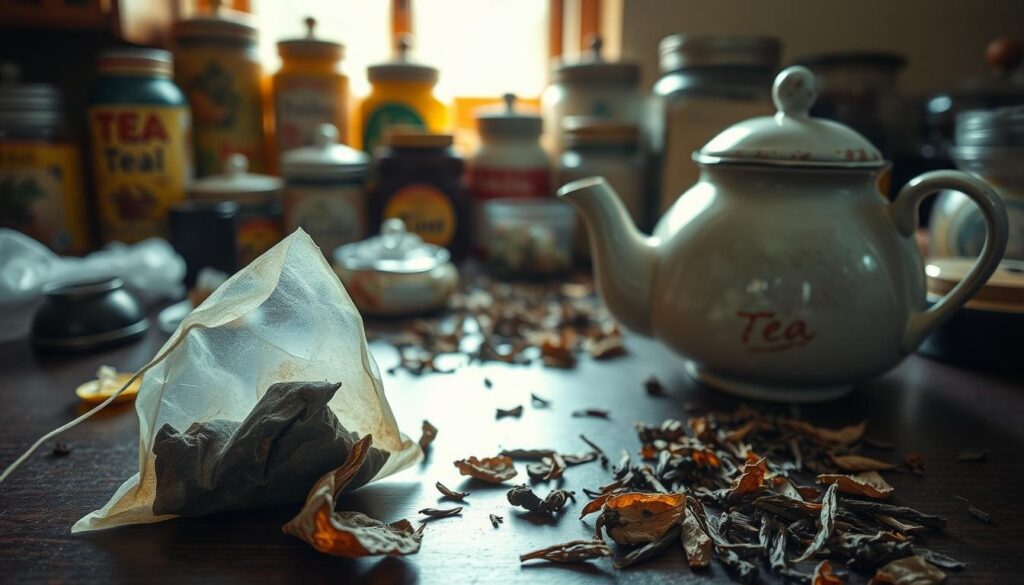
| Sign | What You’ll Notice | Likely Cause | Action |
|---|---|---|---|
| Dull, brittle leaves | Color looks faded; leaves snap easily | Oxidation from air and light | Discard and review how to store tea in opaque, airtight tins |
| Faint or papery aroma | Little to no scent from dry leaf | Volatile oils dissipated over time | Replace; adjust tea storage guide steps to keep tea fresh |
| Cross-scented leaf | Smells like spice rack or fridge | Odor absorption in kitchen | Discard; store away from odors to protect tea shelf life |
| Weak or “off” brew | Thin body, muted notes, odd aftertaste | Staling from heat and air | Replace and improve how to store tea: cool, dark, dry place |
| Unexpected bitterness | Harsher than usual at normal steep | Degraded leaf chemistry | Stop using; recheck tea storage guide for best practices |
| Mold or damp clumps | Musty smell; visible spots or clinging leaves | Moisture intrusion | Discard immediately; switch to airtight containers to keep tea fresh |
| Age vs. aging | Pu-erh or aged white shows complex, clean aroma | Intentional maturation under control | Accept if clean; still follow how to store tea to protect character |
Tips for Long-Term Tea Storage
Store your tea in airtight, opaque tins. Keep them in a cool, dark, dry cabinet for daily use. Greens and whites are best within 6–12 months, while blacks and darker oolongs last 12–18 months. Herbals also shine within 6–12 months. Divide large amounts into smaller jars to lessen air exposure. Remember to label jars with open dates to help you use older teas first. These strategies ensure your tea stays fresh in most kitchens.
To store tea for a long time, start by reducing oxygen. Seal delicate leaves in vacuum packs to minimize air space. For premium Japanese greens, freezing unopened packs keeps their aroma longer. Make sure to warm them to room temperature before opening to avoid moisture build-up. Don’t refreeze them after opening. Store heavily roasted oolongs and black teas in airtight, dark containers at room temperature. This method maintains the tea’s true taste.
Pu-erh teas require a unique approach. Store them in breathable wrappers at a consistent temperature and humidity, away from strong smells and moisture. Don’t fully seal aging pu-erh cakes; they need air. For different teas, keep fragrant teas separate from non-scented ones. Also, store spices and coffee away from your tea stash.
Buying fresher tea helps it last longer. Look for tea sellers who offer clear harvest dates and sell quickly. At home, protect your tea from air, heat, light, and smells. Use clear labels to keep track of what’s in each jar. By following this guide, you can enjoy fresh tea for many months, preserving its unique flavors.

